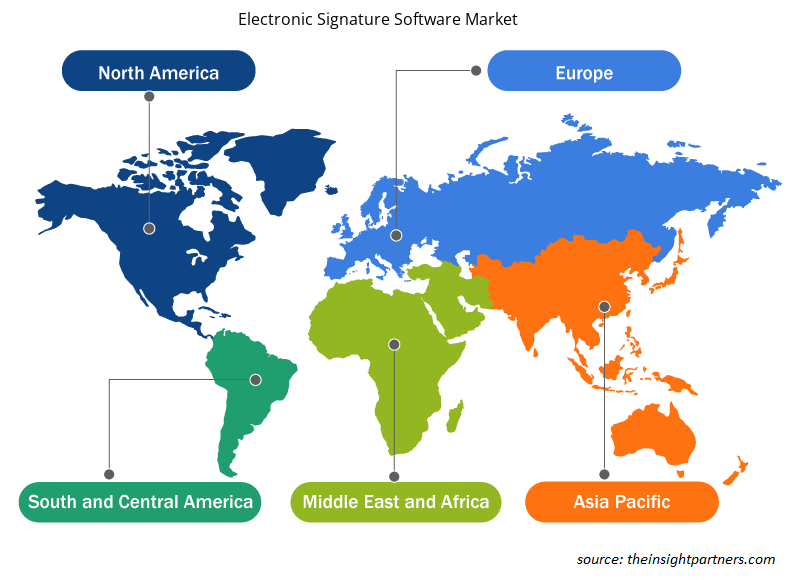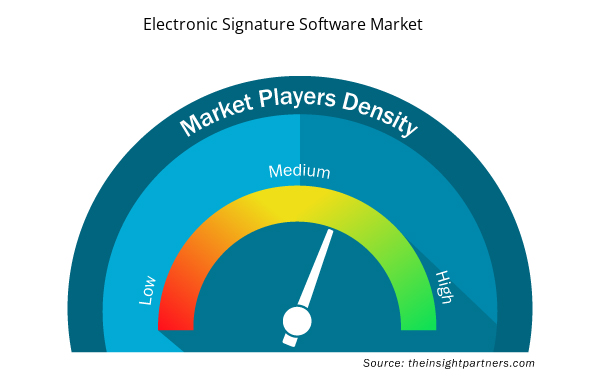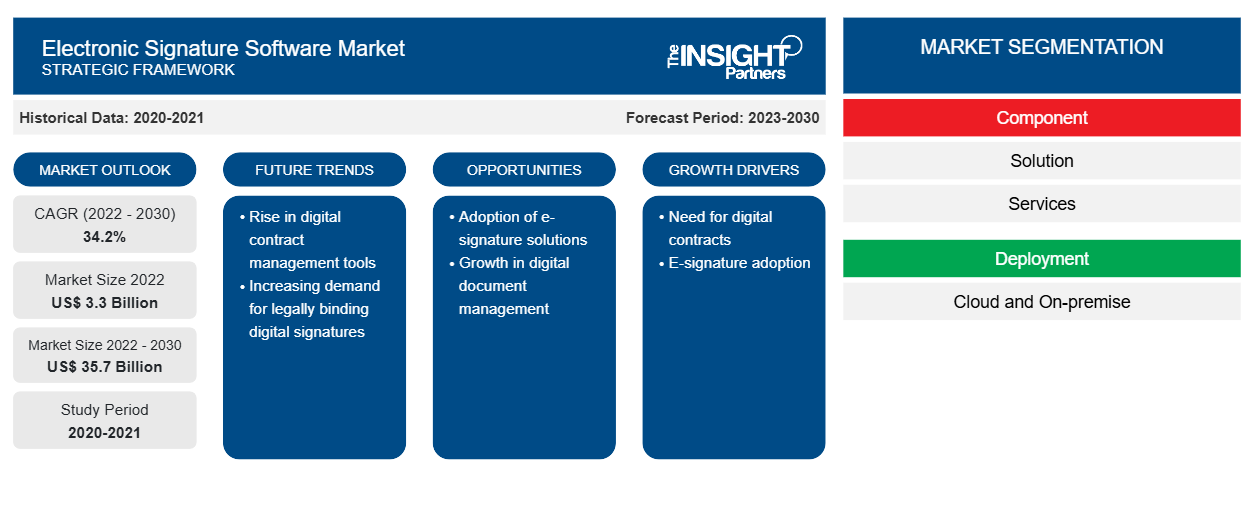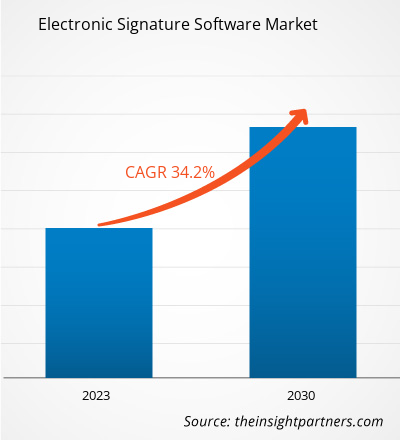[調査レポート] 電子署名ソフトウェア市場は2022年に33億米ドルと評価され、2030年までに357億米ドルに達すると予測されています。また、2022年から2030年にかけて34.2%のCAGRを記録すると予想されています。
アナリストの視点:
クラウド署名などの電子署名は、世界中で最も安全なタイプの電子署名であると考えられています。企業や個人が署名者を識別するために最高レベルの保証を必要とする場合、信頼できる第三者によって検証されたデジタル ID を使用する電子署名を選択することで、取引を保護したり、現地の法律に準拠したりできます。電子署名ソフトウェア市場の成長に貢献している主な要因には、デジタル化の進展、テクノロジーの進歩、エンドツーエンドのサービス向上に対する企業の重点の高まりなどがあります。世界規模で見ると、製造、BFSI、製薬、政府機関、法務は、世界中で電子署名ソフトウェア支出の最前線にある主要な最終用途産業の一部です。
電子署名ソフトウェア市場の概要:
電子署名は、電子文書にすばやく署名するための効果的で合法的な方法です。これは、多くのプロセスで手書きの署名に代わる、安全で信頼できるシステムです。電子署名は、文書に署名する側とそれを受け取る側に優れたセキュリティを提供します。電子署名された文書は、法務部門で大きな可能性を秘めており、これが電子署名ソフトウェア市場の成長を支える大きな要因となっています。電子署名ソフトウェアには、企業がワークフローを合理化できるようにするいくつかの利点があります。電子署名の利点には、ビジネス スピードの向上、文書の精度の向上、コストと時間の最適化、顧客サービスの強化などがあります。
要件に合わせてレポートをカスタマイズする
このレポートの一部、国レベルの分析、Excelデータパックなど、あらゆるレポートを無料でカスタマイズできます。また、スタートアップや大学向けのお得なオファーや割引もご利用いただけます。
- このレポートの主要な市場動向を入手してください。この無料サンプルには、市場動向から見積もりや予測に至るまでのデータ分析が含まれます。
電子署名ソフトウェア市場の推進要因:
企業によるデジタル技術の導入増加
電子署名ソフトウェアは、公的機関だけでなく民間企業でも導入が進んでいます。国際銀行、国内銀行、官公庁、中小企業などでは、重要なデータを保護および管理するためにデジタル署名が必要です。さまざまな企業がデジタル署名を使用して、データ漏洩を防ぎ、ビジネス パートナーや社内手続きとの信頼できるやり取りを確保しています。これは、デジタル署名ソリューションを日常生活に取り入れる若い消費者によってさらに後押しされています。たとえば、Adobe 2020 の調査によると、2019 年から 2020 年にかけて、Adobe の APAC のクライアントの 61% 以上がミレニアル世代でした。APAC were millennials from 2019 to 2020.
さらに、世界中のさまざまな場所に従業員や支店を持つ企業は、プロセスで電子署名の使用を増やしています。承認のために文書を印刷して輸送する必要がなくなるため、時間を短縮できます。また、物理的な文書を長期的に保管および取得することは容易ではありません。2023年10月時点のインド商工会議所連盟(FICCI)のレポートによると、回答者の約35%が、デジタル化の結果、年間運用コストが11〜20%削減されたと報告しています。企業は、デジタル時代に効果的に競争するために、ビジネスをデジタルに変革しています。このように、企業によるデジタル技術の採用の増加は、電子署名ソフトウェア市場の成長を促進します。
電子署名ソフトウェア市場セグメント分析:
電子署名ソフトウェア市場は、コンポーネント、展開、方法、およびエンドユーザーに基づいて分類されています。展開に基づいて、電子署名ソフトウェア市場はクラウドとオンプレミスに分かれています。提供に基づいて、電子署名ソフトウェア市場はソリューションとサービスに分かれています。方法に基づいて、電子署名ソフトウェア市場は、一般的な電子署名、認定電子署名、および拡張電子署名に分類されます。エンドユーザーに基づいて、電子署名ソフトウェア市場は、BFSI、製薬、製造、政府機関、法律、その他に分類されます。地理的に、市場は北米、アジア太平洋、ヨーロッパ、中東およびアフリカ、南米の5つの主要な地域に分割されています。
現在の市場シナリオでは、企業はデータの整合性と透明性を高めた追加機能を提供する費用対効果の高いソリューションの採用に注力しています。世界中のさまざまな組織が電子署名ソリューションを使用しています。たとえば、2023年11月、Lion TravelはDottedSign電子署名ソリューションを採用しました。これにより、同社は旅行契約に署名するためのより効率的で便利で持続可能な方法を実現し、年間約4.5トンの紙の節約が見込まれています。したがって、このような事例は、ソリューションセグメントの電子署名ソフトウェア市場の成長を促進します。
電子署名ソフトウェア市場の地域分析:
ヨーロッパの電子署名ソフトウェア市場は、2022年に10億1,000万米ドルと評価され、2030年までに110億3,000万米ドルに達すると予測されています。2022年から2030年にかけて34.7%のCAGRを記録すると予想されています。ヨーロッパの電子署名ソフトウェア市場は、フランス、ドイツ、ロシア、イタリア、英国、その他のヨーロッパに分かれています。欧州の法律では、電子署名は1999年に採択された電子署名のコミュニティフレームワークに関する指令によって初めて認められました。ヨーロッパでは、2016年7月に電子識別および信頼サービス規則(eIDAS)により、欧州連合(EU)全体の電子署名と文書の法的構造が確立されました。2016年7月以降、この地域の電子署名は電子識別および信頼サービス(eIDAS)規則によって管理されており、すべてのEU加盟国に直接適用できる規制環境を提供し、市民、企業、公的機関間のシームレスで安全な電子的やり取りを可能にします。これにより、企業は地域内で電子署名の利用を開発、拡大するための予測可能な法的環境も得られます。
主要プレーヤー分析:
電子署名ソフトウェア市場の分析は、Adobe Inc.、Docusign, Inc.、Esign Genie、HID Global、Legalesign Limited、OneSpan、RPost、Thales SA、U-SIGN-IT、Zoho Corporation などの主要企業の年間業績に基づいています。市場とそのエコシステムの全体像を把握するために、他のいくつかの重要な電子署名ソフトウェア市場のプレーヤーが分析されました。
電子署名ソフトウェア市場の地域別分析
予測期間を通じて電子署名ソフトウェア市場に影響を与える地域的な傾向と要因は、Insight Partners のアナリストによって徹底的に説明されています。このセクションでは、北米、ヨーロッパ、アジア太平洋、中東およびアフリカ、南米および中米にわたる電子署名ソフトウェア市場のセグメントと地理についても説明します。

- 電子署名ソフトウェア市場の地域別データを入手
電子署名ソフトウェア市場レポートの範囲
| レポート属性 | 詳細 |
|---|---|
| 2022年の市場規模 | 33億米ドル |
| 2030年までの市場規模 | 357億米ドル |
| 世界のCAGR(2022年 - 2030年) | 34.2% |
| 履歴データ | 2020-2021 |
| 予測期間 | 2023-2030 |
| 対象セグメント | コンポーネント別
|
| 対象地域と国 | 北米
|
| 市場リーダーと主要企業プロフィール |
|
市場プレーヤーの密度:ビジネスダイナミクスへの影響を理解する
電子署名ソフトウェア市場は、消費者の嗜好の変化、技術の進歩、製品の利点に対する認識の高まりなどの要因により、エンドユーザーの需要が高まり、急速に成長しています。需要が高まるにつれて、企業は提供内容を拡大し、消費者のニーズを満たすために革新し、新たなトレンドを活用し、市場の成長をさらに促進しています。
市場プレーヤー密度とは、特定の市場または業界内で活動している企業または会社の分布を指します。これは、特定の市場スペースに、その市場規模または総市場価値に対してどれだけの競合相手 (市場プレーヤー) が存在するかを示します。
電子署名ソフトウェア市場で事業を展開している主要企業は次のとおりです。
- アドビ株式会社
- ドキュサイン株式会社
- 電子サイン ジーニー
- HIDグローバル
- リーガルデザインリミテッド
免責事項:上記の企業は、特定の順序でランク付けされていません。

- 電子署名ソフトウェア市場のトップキープレーヤーの概要を入手
最近の動向:
電子署名ソフトウェア市場の企業は、ビジネスの成長のために、無機的戦略と有機的戦略の両方に重点を置いています。上記の電子署名ソフトウェア市場のプレーヤーによる最近の主要な市場動向をいくつか以下に示します。
- 2023 年、Adobe Inc は Acrobat Sign を Salesforce と統合し、信頼できる電子署名を使用して組織がより迅速に業務を遂行できるようにしました。Acrobat Sign は、あらゆるデバイスから数秒でサインインできるようにすることで顧客にメリットをもたらし、承認プロセスに関わるすべての人の生産性を向上させます。
- 2023年、DocuSign Inc.は生体認証チェックを行うためのAI搭載ID検証ソリューションを開始しました。これにより、署名者は署名プロセス中に有効な身分証明書を物理的に提示できるようになります。
- 過去2年間の分析、基準年、CAGRによる予測(7年間)
- PEST分析とSWOT分析
- 市場規模価値/数量 - 世界、地域、国
- 業界と競争環境
- Excel データセット


- Pharmacovigilance and Drug Safety Software Market
- Social Employee Recognition System Market
- Terahertz Technology Market
- Parking Management Market
- Nuclear Decommissioning Services Market
- Clear Aligners Market
- Point of Care Diagnostics Market
- Cell Line Development Market
- Advanced Planning and Scheduling Software Market
- Real-Time Location Systems Market

Report Coverage
Revenue forecast, Company Analysis, Industry landscape, Growth factors, and Trends

Segment Covered
This text is related
to segments covered.

Regional Scope
North America, Europe, Asia Pacific, Middle East & Africa, South & Central America

Country Scope
This text is related
to country scope.
よくある質問
The global electronic signature software market was estimated to be US$ 3.39 billion in 2022 and is expected to grow at a CAGR of 34.2% % during the forecast period 2023 - 2030.
Rising adoption of digital technologies by enterprises, growing number of green initiatives, and increasing use of electronic signatures in e-commerce industry are some of the drivers for the market.
High implementation of electronic signatures across SMEs is impacting positive impact, which is anticipated to play a significant role in the global electronic signature software market in the coming years.
The key players holding majority shares in the global electronic signature software market are Adobe Inc., Docusign, Inc., Esign Genie, HID Global, and Legalesign Limited.
The incremental growth expected to be recorded for the global electronic signature software market during the forecast period is US$ 32,311.99 million.
The global electronic signature software market is expected to reach US$ 35,707.44 million by 2030.
Trends and growth analysis reports related to Technology, Media and Telecommunications : READ MORE..
The List of Companies - Electronic Signature Software Market
- Adobe Inc.
- Docusign, Inc.
- Esign Genie
- HID Global
- Legalesign Limited
- OneSpan
- RPost
- Thales S.A.
- U-SIGN-IT
- Zoho Corporation
The Insight Partners performs research in 4 major stages: Data Collection & Secondary Research, Primary Research, Data Analysis and Data Triangulation & Final Review.
- Data Collection and Secondary Research:
As a market research and consulting firm operating from a decade, we have published and advised several client across the globe. First step for any study will start with an assessment of currently available data and insights from existing reports. Further, historical and current market information is collected from Investor Presentations, Annual Reports, SEC Filings, etc., and other information related to company’s performance and market positioning are gathered from Paid Databases (Factiva, Hoovers, and Reuters) and various other publications available in public domain.
Several associations trade associates, technical forums, institutes, societies and organization are accessed to gain technical as well as market related insights through their publications such as research papers, blogs and press releases related to the studies are referred to get cues about the market. Further, white papers, journals, magazines, and other news articles published in last 3 years are scrutinized and analyzed to understand the current market trends.
- Primary Research:
The primarily interview analysis comprise of data obtained from industry participants interview and answers to survey questions gathered by in-house primary team.
For primary research, interviews are conducted with industry experts/CEOs/Marketing Managers/VPs/Subject Matter Experts from both demand and supply side to get a 360-degree view of the market. The primary team conducts several interviews based on the complexity of the markets to understand the various market trends and dynamics which makes research more credible and precise.
A typical research interview fulfils the following functions:
- Provides first-hand information on the market size, market trends, growth trends, competitive landscape, and outlook
- Validates and strengthens in-house secondary research findings
- Develops the analysis team’s expertise and market understanding
Primary research involves email interactions and telephone interviews for each market, category, segment, and sub-segment across geographies. The participants who typically take part in such a process include, but are not limited to:
- Industry participants: VPs, business development managers, market intelligence managers and national sales managers
- Outside experts: Valuation experts, research analysts and key opinion leaders specializing in the electronics and semiconductor industry.
Below is the breakup of our primary respondents by company, designation, and region:

Once we receive the confirmation from primary research sources or primary respondents, we finalize the base year market estimation and forecast the data as per the macroeconomic and microeconomic factors assessed during data collection.
- Data Analysis:
Once data is validated through both secondary as well as primary respondents, we finalize the market estimations by hypothesis formulation and factor analysis at regional and country level.
- Macro-Economic Factor Analysis:
We analyse macroeconomic indicators such the gross domestic product (GDP), increase in the demand for goods and services across industries, technological advancement, regional economic growth, governmental policies, the influence of COVID-19, PEST analysis, and other aspects. This analysis aids in setting benchmarks for various nations/regions and approximating market splits. Additionally, the general trend of the aforementioned components aid in determining the market's development possibilities.
- Country Level Data:
Various factors that are especially aligned to the country are taken into account to determine the market size for a certain area and country, including the presence of vendors, such as headquarters and offices, the country's GDP, demand patterns, and industry growth. To comprehend the market dynamics for the nation, a number of growth variables, inhibitors, application areas, and current market trends are researched. The aforementioned elements aid in determining the country's overall market's growth potential.
- Company Profile:
The “Table of Contents” is formulated by listing and analyzing more than 25 - 30 companies operating in the market ecosystem across geographies. However, we profile only 10 companies as a standard practice in our syndicate reports. These 10 companies comprise leading, emerging, and regional players. Nonetheless, our analysis is not restricted to the 10 listed companies, we also analyze other companies present in the market to develop a holistic view and understand the prevailing trends. The “Company Profiles” section in the report covers key facts, business description, products & services, financial information, SWOT analysis, and key developments. The financial information presented is extracted from the annual reports and official documents of the publicly listed companies. Upon collecting the information for the sections of respective companies, we verify them via various primary sources and then compile the data in respective company profiles. The company level information helps us in deriving the base number as well as in forecasting the market size.
- Developing Base Number:
Aggregation of sales statistics (2020-2022) and macro-economic factor, and other secondary and primary research insights are utilized to arrive at base number and related market shares for 2022. The data gaps are identified in this step and relevant market data is analyzed, collected from paid primary interviews or databases. On finalizing the base year market size, forecasts are developed on the basis of macro-economic, industry and market growth factors and company level analysis.
- Data Triangulation and Final Review:
The market findings and base year market size calculations are validated from supply as well as demand side. Demand side validations are based on macro-economic factor analysis and benchmarks for respective regions and countries. In case of supply side validations, revenues of major companies are estimated (in case not available) based on industry benchmark, approximate number of employees, product portfolio, and primary interviews revenues are gathered. Further revenue from target product/service segment is assessed to avoid overshooting of market statistics. In case of heavy deviations between supply and demand side values, all thes steps are repeated to achieve synchronization.
We follow an iterative model, wherein we share our research findings with Subject Matter Experts (SME’s) and Key Opinion Leaders (KOLs) until consensus view of the market is not formulated – this model negates any drastic deviation in the opinions of experts. Only validated and universally acceptable research findings are quoted in our reports.
We have important check points that we use to validate our research findings – which we call – data triangulation, where we validate the information, we generate from secondary sources with primary interviews and then we re-validate with our internal data bases and Subject matter experts. This comprehensive model enables us to deliver high quality, reliable data in shortest possible time.


 このレポートの無料サンプルを入手する
このレポートの無料サンプルを入手する